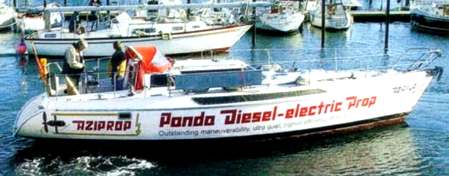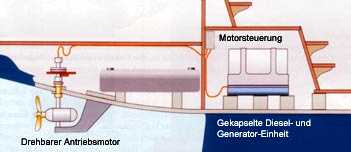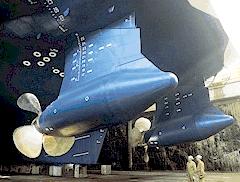|
It might not sound very spectacular, but the
advantages can be significant. In large cruise liners, electric
motors drive propellers directly for smother running.
There is no direct mechanical connection. Tugs
and research ships have been using drives without mechanical
switching units for some time, on account of their
manoeuvrability, and high efficiency, in partial load range.
Many naval boots have electrical cruising motors, which must run
extremely quietly.
Article
in "Yacht" on 21.04.04 -
Innovation: The perfect alternative to a ship diesel

PANDA
diesel-electric boat
Test
Boat
The Icemaster test yacht, 35 foot Motor sail
boat, carries the E-Motor in a type of pod under the hull. It
can rotate 180 degrees. The Permanent Magnet Machine is a
brushless DC motor. An Electronic Control produces the otherwise
normal pole winding. It not only runs without wear, but is,
above all more effective.
In order to achieve a drive performance of 12
Kilowatt with low current, the motor is driven by up to 480
Volts, generated by a 14-Kilowatt- Fischer Panda generator. It
has little to do with generation of power, apart from the
principle, how they can be made available for 230-Volt-devices.
These would simply be too inflexible for ship propulsion. True,
the Fischer-Panda-Generator also internally generates AC, but
optimized for powering DC circuits. The speed of the diesel
motor is infinitely adjusted to match the required drive
performance.
AC Generators, on the other hand, run at constant
speed, in order to generate a frequency of 50HZ. This means,
they run at 3000 rpm without load. Conventional ship diesels are
similarly inefficient. They are so designed that at full speed,
the nominal speed and also the highest performance is achieved.
More torque is available in the partial load range, than can be
produced by the screw in the water.
This is exactly where the great energy saving
potential of the Fischer Panda concept can be found: In the case
of electrical power transmission, the speed of the propeller and
ship diesel are extensively disconnected. The Generator can
always run economically in this range.
The „Aziprop". This is the name of the
test yacht, consumes less than half the fuel during cruising,
since modification has been carried out, in comparison to the
previously installed 38PS diesel. And: There is indeed more
power available during manoeuvring, because of the torque
characteristic, which is more suitable for ship propulsion.
In addition, highly powerful AC power supply. On
board, 230 volt devices can easily be run by the DC system via
an inverter. Smaller consumers, such as hair dryers or laptops
are powered by the batteries. The diesel generator automatically
starts, as soon as the rechargeable batteries lose power. Up to
4 Kilowatt is then available – more than enough, even for an
air conditioning unit.

Generator
diesel-electric installation
Economy
Only in the case of sailing yachts was this
comfortable and economical technology not used as being too heavy and
too expensive. The generator manufacturer, „Icemaster“,
better known as „Fischer Panda“ have been working for five
years to find a suitable solution for small boats. The „YACHT“magazine
have, for the first time, published the results of a boat with a
fully tested diesel electric drive.
The Principle is simple: A normal diesel motor is
driven by a large generator. This unit, known in expert circles,
as genset is fully contained in a capsule and supplies power to
the electrical cruise motor. The reverse gear functions and gear
reduction are electronically controlled.
Until a few years ago, the price and effort
required for the necessary components bore no relation to the
achieve-able advantages, at least, for the normal drive
performance of yachts. The use of the most modern technology
means the concept is now ripe for this system to be also
installed into sport boats. Icemaster use brushless DC motors
and an innovative electronic control. This improves the system
enormously. The cruising motor and generator, for example, are
almost identical, which reduces the development and
manufacturing costs. This should not be mistaken for purely
electrical driven boat drives, which are nowadays, in general
use. The battery bank is used as a buffer. The range, using
batteries, for long sailing trips along the coast or at sea, is,
however, to small; that is why this concept is suitable,
fore-mostly for inland waters. The diesel electric drive, on the
other hand, generates the cruising current, whenever it is
required, and the range is superior to conventional ships.
Azimuting
podded propulsion systems have already been approved in the big
ship building industry for several years.Shortly after its
introduction, the system became the standard solution. Many
newly designed oceangoing passanger cruising vessels built later
after 1999 have this outstanding new propusion system fitted.
The motors are avalable up to 20.000 kW performance per unit
with up to 3 units mounted underneath the hull.

Cruise
ship installation
Comfort
The lack of noise is impressive whilst cruising
at 6 Knots: gulls crying, the bow wave splashes quietly and
somewhere in the fjord, a freight ship can be heard chugging
along. The motor and generator run in sound insulated capsules
below deck. Practically only the cooling water discharge can be
heard. This is no comparison to the racket made by some ships`
diesels.
There are two reasons for the unusual peace;
firstly there are no sound or vibration jumpers at the hull. All
mountings are cushioned – there is no mechanical connection
between motor and prop, such as shaft or sail drive. Secondly,
the diesel electric drive is doubly insulated, because the
installed diesel and generator unit, located in the engine room,
are additionally in a capsule.
Disconnection of the motor and propeller has
further advantages. The generator can be placed where it will
not take up too much space. In addition, it is easy top lay the
cables to the E-Motor. On catamarans, a central “power
plant” suffices for both drives.
The costs for a diesel electric drive are, true,
somewhat greater than the classic diesel. The generator is
supplied as well. Reason enough to consider this convincing
concept. Icemaster are already working on the next
project. A series Volvo Penta Diesel Bavaria 49 is being
converted to electrical power transmission.

180
degree turning - no need for bow thruster
Aziprop
is the registered trade mark of Fischer Panda. Fischer Panda has
developed the System based on the AGT Permanent Magnet Motor
Technology. These electric motors are based on the latest
technology. Fischer Panda has been involved with this
technology for more than 10 years. The
Panda DE Aziprop system combines both electric motor and
propeller into one unit. The motor is located underneath the
hull, in a rotatable gondel (a fully sealed stainless steel
housing.)
Further
Information regarding Bavaria 49DE and Whisper prop can
be found on the following Links:
www.bavaria-fischerpande.de
www.whisperprop.de
htttp://www.fischerpanda.de/eng
http://www.whisperprop.de/eng
http://www.aziprop.de/eng
http://www.bavaria-fischerpanda.de/eng
Fischer
Panda Generatoren ICEMASTER GmbH -
Otto-Hahn-Str. 40 D-33104 Paderborn - Germany
Tel.+49 (0)5254 - 92020 Fax.+49 (0)5254 -
85724
|



